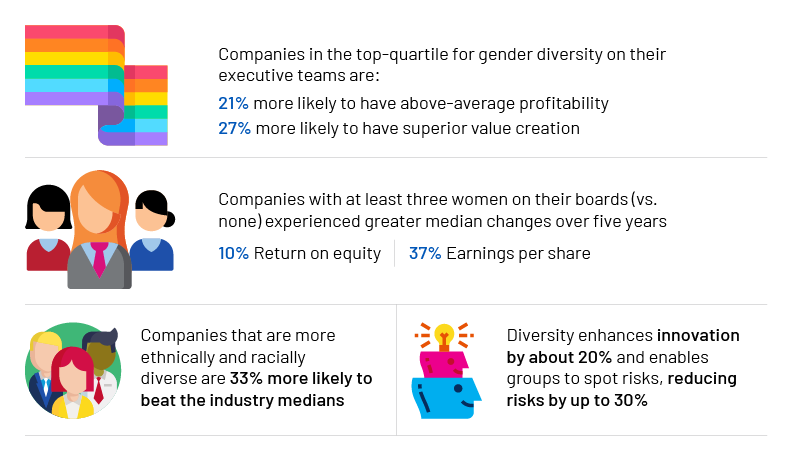Published on November 15, 2019 by Ananya Ghosh
Surprisingly or not, an increasing number of studies are showing that companies with diverse workforces are seeing improved financial performance, increased market share, and enhanced brand recognition, while attracting top talent. Given the multiple tangible and intangible benefits, leading companies are viewing diversity and inclusion (D&I) as a strategic priority that can no longer be ignored.
On the face of it, organizational diversity refers to equality of opportunity and employment without any bias because of age, gender, religion, nationality, culture, disability, or education. In reality, though, it encompasses far more imperceptible attributes such as perspectives, belief systems, values, lifestyles, motivations, ambitions, and backgrounds.
While some of us suppress our uniqueness in the fear of becoming an outcast, leading companies are embracing diversity, as studies confirm that employees are happier and more productive when they feel valued for who they are!
Is there evidence of a D&I-driven improvement in financial performance?
Not only does incorporating D&I in an organization feels like the “right” thing to do ethically, but it also appears to have multiple positive side effects on a business. Researchers are now digging deeper, and recent findings support the claim that D&I makes sense, even from a purely economic perspective.

How does the powerful psychology of D&I manifest?
Conformity kills creativity, but diversity boosts it. An SAP Research report quotes Adam Stanley, global chief digital and information officer at Cushman & Wakefield Inc. as saying, “If you have five people in the room and they are all of the same background, experience, socioeconomic perspective, race, or gender, you lose a lot of value.”
This idea finds a corollary in the fact that interaction and collaboration with people of diverse mindsets, perspectives, and experiences enliven discussions and fuel new ideas and innovation within a firm. D&I is also often associated with an open mindset, especially attractive to the growing talent pool of millennials and the Gen-Z demographic. Furthermore, in our ever-connected global economy, culturally diverse companies are perceived to be better at catering to clients’ needs, and ethically, they fulfill a key social responsibility, improving the perception of a brand.
In a nutshell, organizations that encourage D&I are able to trigger a chain reaction that impacts positively the key aspects that influence a firm’s performance.
D&I – The chain reaction (Quotes from successful individuals and companies who have discovered the power of D&I)

Are companies losing out when they ignore inclusion?
“Diversity is being invited to the party. Inclusion is being asked to dance.” – Verna Myers, VP of Inclusion Strategy at Netflix
Diversity is often lumped together with inclusion, but psychologist Bill Crawford says they are not the same. One is a description of what it is, while the other describes a style of interaction that is essential for effective teams and organizations.
For example, a big American footwear company recently came under fire due to claims that its work environment was not respectful or inclusive of female employees, and that some of them had been declined career advancements based on gender or race. However, the said company is largely comprised of women, with females representing one fifth of the board of directors and one thirds of the company’s leadership.
Unfortunately, several companies have yet to put in place the right initiatives to drive inclusion. A D&I benchmarking survey conducted by PricewaterhouseCoopers reveals that all regions, with the exception of North America, have struggled to translate D&I strategy into action.
We believe, therefore, that making D&I part of a company’s core strategy could help it tap the substantial potential available. It is also worth highlighting that without inclusion, diversity has little value other than, perhaps, aesthetically.
Firms (especially those in the professional services domain) that focus on D&I initiatives are, therefore, more likely to see significant gains, as they benefit not only from a broad range of ideas from their multi-dimensional talent pools, but also from the greater agility and creativity that come with such a culture. Companies that have diverse talent pools with diverse perspectives and thinking – in essence, a reflection of the societies we live and work in – are likely to be best positioned to deliver value for their clients.
D&I – The Acuity Knowledge Partners advantage
Our strong D&I initiatives ensure we are well placed to drive innovation and productive ingenuity. They also help us to understand the requirements of clients from varied backgrounds and with different cultural preferences, providing the flexibility we need to meet their diverse needs. Additionally, our in-depth study of best practices allows us to help companies drive D&I through multiple research offerings such as benchmarking, D&I-related regulatory updates, and global and regional D&I newsletters.
References:
McKinsey and Company: Delivering through Diversity Report
HBR research report
Deloitte report
BCG findings
MSCI Report
PwC survey report
What's your view?
About the Author
Ananya is part of the firm’s Corporate Strategy, Research, and Content practice. She oversees multiple client engagements, including those within the domains of media monitoring, content creation, validation, and research. Ananya has over 11 years of experience in research and outsourcing management in diverse fields, such as strategy, business, equity, and credit research.
Prior to her role at Acuity Knowledge Partners, she worked at a KPO, where her responsibilities largely included supporting investment banks and managing clients and other research engagements. Ananya is a CFA charter holder (USA) and holds a Bachelor of Arts (Economics).
Like the way we think?
Next time we post something new, we'll send it to your inbox








